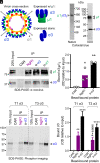NgR1 binding to reovirus reveals an unusual bivalent interaction and a new viral attachment protein
- PMID: 37276413
- PMCID: PMC10268256
- DOI: 10.1073/pnas.2219404120
NgR1 binding to reovirus reveals an unusual bivalent interaction and a new viral attachment protein
Abstract
Nogo-66 receptor 1 (NgR1) binds a variety of structurally dissimilar ligands in the adult central nervous system to inhibit axon extension. Disruption of ligand binding to NgR1 and subsequent signaling can improve neuron outgrowth, making NgR1 an important therapeutic target for diverse neurological conditions such as spinal crush injuries and Alzheimer's disease. Human NgR1 serves as a receptor for mammalian orthoreovirus (reovirus), but the mechanism of virus-receptor engagement is unknown. To elucidate how NgR1 mediates cell binding and entry of reovirus, we defined the affinity of interaction between virus and receptor, determined the structure of the virus-receptor complex, and identified residues in the receptor required for virus binding and infection. These studies revealed that central NgR1 surfaces form a bridge between two copies of viral capsid protein σ3, establishing that σ3 serves as a receptor ligand for reovirus. This unusual binding interface produces high-avidity interactions between virus and receptor to prime early entry steps. These studies refine models of reovirus cell-attachment and highlight the evolution of viruses to engage multiple receptors using distinct capsid components.
Keywords: Nogo receptor 1; attachment; receptor; structure; virus.
Conflict of interest statement
The authors declare no competing interest.
Figures






Similar articles
-
The Murine Neuronal Receptor NgR1 Is Dispensable for Reovirus Pathogenesis.J Virol. 2022 Apr 27;96(8):e0005522. doi: 10.1128/jvi.00055-22. Epub 2022 Mar 30. J Virol. 2022. PMID: 35353001 Free PMC article.
-
Viral capsid structural assembly governs the reovirus binding interface to NgR1.Nanoscale Horiz. 2024 Oct 21;9(11):1925-1937. doi: 10.1039/d4nh00315b. Nanoscale Horiz. 2024. PMID: 39347978 Free PMC article.
-
The Nogo receptor NgR1 mediates infection by mammalian reovirus.Cell Host Microbe. 2014 Jun 11;15(6):681-91. doi: 10.1016/j.chom.2014.05.010. Cell Host Microbe. 2014. PMID: 24922571 Free PMC article.
-
mGem: The complexity of viral entry-one virus, many receptors.mBio. 2025 Mar 12;16(3):e0296424. doi: 10.1128/mbio.02964-24. Epub 2025 Feb 11. mBio. 2025. PMID: 39932305 Free PMC article. Review.
-
Attachment and cell entry of mammalian orthoreovirus.Curr Top Microbiol Immunol. 2006;309:1-38. doi: 10.1007/3-540-30773-7_1. Curr Top Microbiol Immunol. 2006. PMID: 16909895 Review.
Cited by
-
From viral assembly to host interaction: AFM's contributions to virology.J Virol. 2025 Jan 31;99(1):e0087324. doi: 10.1128/jvi.00873-24. Epub 2024 Dec 10. J Virol. 2025. PMID: 39655953 Free PMC article. Review.
-
Strain-specific differences in reovirus infection of murine macrophages segregate with polymorphisms in viral outer-capsid protein σ3.J Virol. 2024 Nov 19;98(11):e0114724. doi: 10.1128/jvi.01147-24. Epub 2024 Oct 21. J Virol. 2024. PMID: 39431846 Free PMC article.
-
The reovirus variant RP116 is oncolytic in immunocompetent models and generates reduced neutralizing antibodies to Type 3 Dearing.Mol Ther Oncol. 2024 Jun 29;32(3):200846. doi: 10.1016/j.omton.2024.200846. eCollection 2024 Sep 19. Mol Ther Oncol. 2024. PMID: 39354956 Free PMC article.
-
Cell surface heparan sulfate is an attachment receptor for grass carp reovirus.iScience. 2025 Feb 15;28(3):112033. doi: 10.1016/j.isci.2025.112033. eCollection 2025 Mar 21. iScience. 2025. PMID: 40104073 Free PMC article.
-
NRP1 is a receptor for mammalian orthoreovirus engaged by distinct capsid subunits.Cell Host Microbe. 2024 Jun 12;32(6):980-995.e9. doi: 10.1016/j.chom.2024.04.014. Epub 2024 May 9. Cell Host Microbe. 2024. PMID: 38729153 Free PMC article.
References
-
- Margolis G., Kilham L., Hydrocephalus in hamsters, ferrets, rats, and mice following inoculations with reovirus type I. II. Pathologic studies. Lab Invest. 21, 189–198 (1969). - PubMed
-
- Raine C. S., Fields B. N., Reovirus type 3 encephalitis-a virologic and ultrastructural study. J. Neuropathol. Exp. Neurol. 32, 19–33 (1973). - PubMed
-
- Lerner A. M., Cherry J. D., Klein J. O., Finland M., Infections with reoviruses. N. Engl. J. Med. 267, 947–952 (1962). - PubMed
Publication types
MeSH terms
Substances
Grants and funding
LinkOut - more resources
Full Text Sources

